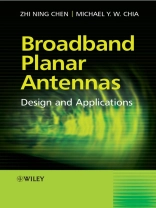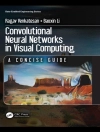The increasing demand for wireless communications has
revolutionised the lifestyle of today’s society and one of
the key components of wireless technology is antenna design.
Broadband planar antennas are the newest generation of antennas
boasting the attractive features required, such as broad operating
bandwidth, low profile, light weight, low cost and ease of
integration into arrays or Radio Frequency (RF) circuits, to make
them ideal components of modern communications systems. Research
into small and broadband antennas has been spurred by the rapid
development of portable wireless communication devices such as cell
phones, laptops and personal digital assistants.
This all-encompassing volume, Broadband Planar Antennas:
Design and Applications, systematically describes the
techniques for all planar antennas from microstrip patch antennas,
suspended plate antennas and planar inverted-L/F antennas to planar
dipole antennas. Also discussed are some of the most recent
outcomes such as broadband antenna issues in promising
ultra-wideband applications.
* Clearly describes the fundamentals of planar antennas and
categorises them according to their radiation characteristics
* Introduces the advanced progress in broadband planar antennas
for modern wireless communications
* Includes a wealth of case studies, design guidelines, figures
and tables
This text is essential reading for antenna, RF and microwave
engineers and manufacturers within the telecommunications industry.
Its highly accessible approach will also appeal to researchers,
postgraduate students and academic lecturers.
Tabela de Conteúdo
Foreword.
Preface.
Acknowledgements.
1 Planar Radiators.
1.1 Introduction.
1.2 Bandwidth Definitions.
1.2.1 Impedance Bandwidth.
1.2.2 Pattern Bandwidth.
1.2.3 Polarization or Axial-ratio Bandwidth.
1.2.4 Summary.
1.3 Planar Antennas.
1.3.1 Suspended Plate Antennas.
1.3.2 Bent Plate Antennas.
1.4 Overview of this Book.
References.
2 Broadband Microstrip Patch Antennas.
2.1 Introduction.
2.2 Important Features of Microstrip Patch Antennas.
2.2.1 Patch Shapes.
2.2.2 Substrates.
2.2.3 Feeding Structures.
2.2.4 Example: Rectangular Microstrip Patch Antennas.
2.3 Broadband Techniques.
2.3.1 Lowering the Q.
2.3.2 Using an Impedance Matching Network.
2.3.3 Case Study: Microstrip Patch Antenna with Impedance
Matching Stub.
2.3.4 Introducing Multiple Resonances.
2.3.5 Case Study: Microstrip Patch Antenna with Stacked
Elements.
References.
3 Broadband Suspended Plate Antennas.
3.1 Introduction.
3.2 Techniques to Broaden Impedance Bandwidth.
3.2.1 Capacitive Load.
3.2.2 Slotted Plates.
3.2.3 Case Study: SPA with an -shaped Slot.
3.2.4 Electromagnetic Coupling.
3.2.5 Nonplanar Plates.
3.2.6 Vertical Feed Sheet.
3.3 Techniques to Enhance Radiation Performance.
3.3.1 Radiation Characteristics of SPAs.
3.3.2 SPA with Dual Feed Probes.
3.3.3 Case Study: Center-concaved SPA with Dual Feed Probes.
3.3.4 SPA with Half-wavelength Probe-fed Strip.
3.3.5 SPA with Probe-fed Center Slot.
3.3.6 Case Study: Center-fed SPA with Double L-shaped
Probes.
3.3.7 SPA with Slots and Shorting Strips.
3.4 Arrays with Suspended Plate Elements.
3.4.1 Mutual Coupling between Two Suspended Plate Elements.
3.4.2 Reduced-size Array above Double-tiered Ground Plane.
References.
4 Planar Inverted-L/F Antennas.
4.1 Introduction.
4.2 The Inverted-L/F Antenna.
4.3 Broadband Planar Inverted-F/L Antenna.
4.3.1 Planar Inverted-F Antenna.
4.3.2 Planar Inverted-L Antenna.
4.4 Case Studies.
4.4.1 Handset Antennas.
4.4.2 Laptop Computer Antennas.
References.
5 Planar Monopole Antennas and Ultra-wideband
Applications.
5.1 Introduction.
5.2 Planar Monopole Antenna.
5.2.1 Planar Bi-conical Structure.
5.2.2 Planar Monopoles.
5.2.3 Roll Monopoles.
5.2.4 EMC Feeding Methods.
5.3 Planar Antennas for UWB Applications.
5.3.1 Ultra-wideband Technology.
5.3.2 Considerations for UWB Antennas and Source Pulses.
5.3.3 Planar UWB Antenna and Assessment.
5.4 Case Studies.
5.4.1 Planar UWB Antenna Printed on a PCB.
5.4.2 Planar UWB Antenna Embedded into a Laptop Computer.
5.4.3 Planar Directional UWB Antenna.
References.
Index
Sobre o autor
Dr Zhi Ning Chen is the Radio Systems Department Manager at the Institute for Infocomm Research in Singapore and is concurrently teaching at the National University of Singapore. Dr Chen has extensive R&D and teaching experience in wireless communications, electromagnetic applications, antennas and propagation. His current research interests are in antennas for cellular systems, WLANs, portable terminals and UWB radio systems.
Dr Michael Chia, is the Division Director for Communications and Devices at the Institute for Infocomm Research in Singaporewhich specialises in the R&D of novel radio technology for wireless communications. Dr Chia was a member in the Panel of Public Service Funding-PSF of the Agency for Science, Technology & Research and has been listed in Marquis Who’s Who in Science and Engineering.












